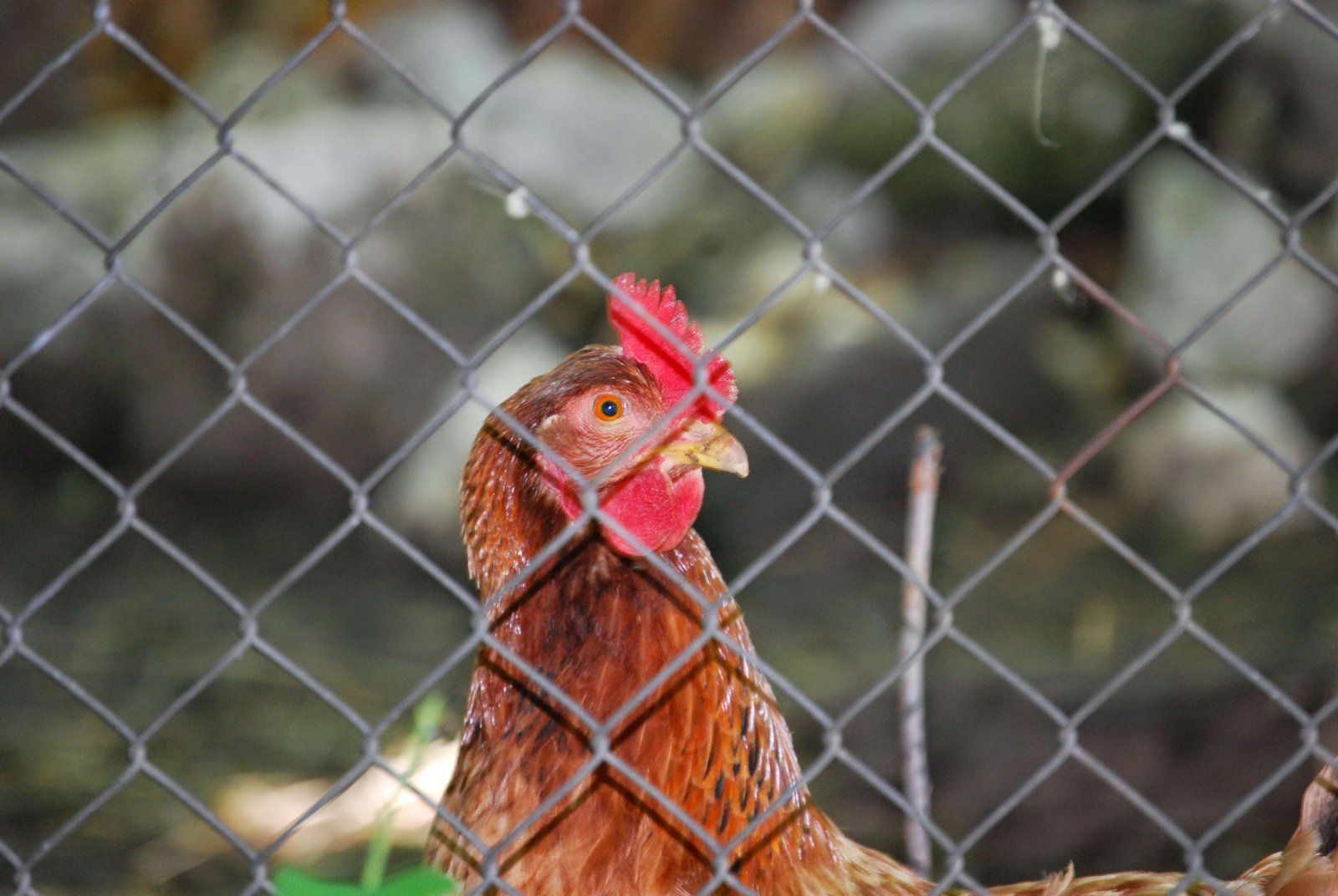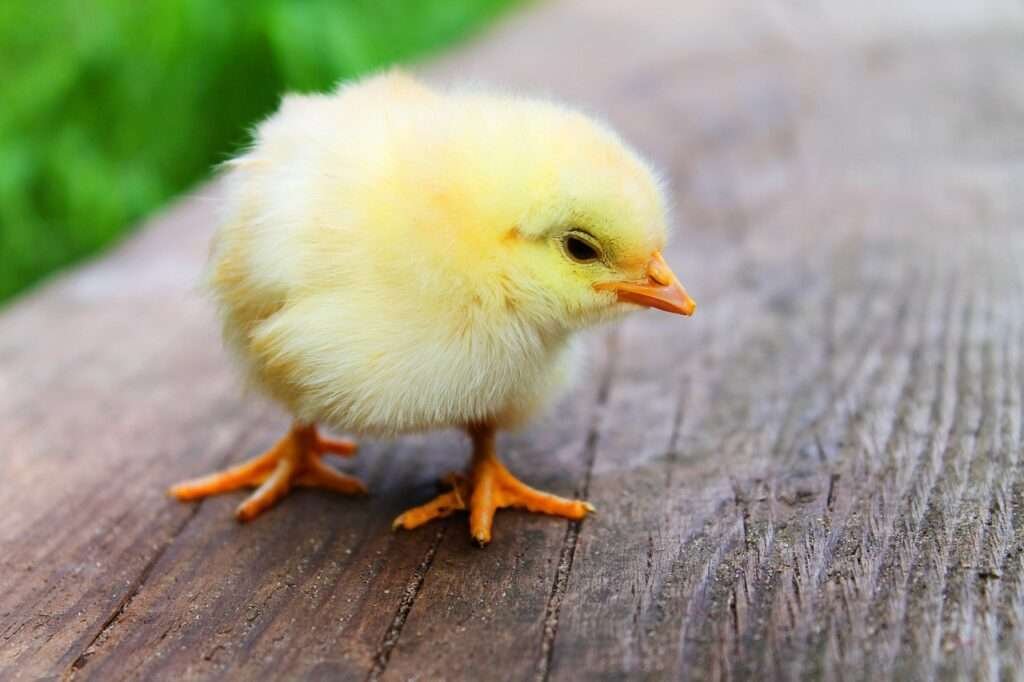The charm of backyard chickens is undeniable. Their playful clucks, quirky personalities, and the delightful prospect of farm-fresh eggs are enough to entice anyone into the world of poultry keeping. But as any chicken owner knows, chickens are inquisitive creatures with a knack for finding their way into unexpected places. If you’ve found yourself with a porch frequented by your feathered friends, complete with unsightly droppings and a trail of feathers, you’re not alone. In this article, we’ll explore the reasons why chickens are drawn to your porch, the downsides of their presence, and the top 5 effective ways for keeping chickens off your porch.

Understanding Why Chickens Roost on Your Porch
Chickens on your porch might seem like an odd occurrence, but it’s often rooted in their natural behavior and instincts. Understanding why they choose this spot can help you address the issue more effectively.
The Role of Shelter and Security
Chickens instinctively seek shelter and security from predators, harsh weather conditions, and potential threats. Your porch, with its roof and raised platform, offers a sense of protection that appeals to them. The porch provides a cozy, covered space where they can perch safely.
The Association of Humans with Food
Chickens are quick to associate humans with food. If you’ve ever fed your chickens on the porch or spent time there with treats, they may come to view it as a prime location for a snack. Their presence is driven by the hope of a tasty treat.
Natural Curiosity and Exploration
Chickens are naturally curious creatures, and they love to explore new environments. Your porch, with its nooks and crannies, can pique their interest. They may simply be following their curiosity to see what’s hiding under the porch or within its corners.
The Downside of Chickens on Your Porch
While the sight of chickens on your porch can be charming at first, it can quickly lead to several issues that prompt homeowners to seek solutions. Understanding the potential downsides is essential in determining the best course of action.
Damage to Property and Furniture
Chickens can be surprisingly destructive when they decide to roost on your porch. They may scratch at wooden surfaces, peck at paint, or damage furniture with their sharp beaks and claws. Over time, this can result in costly repairs or replacements.
Health Risks from Chicken Droppings
Chicken droppings are not only unsightly but also pose health risks. They can contain harmful pathogens, such as bacteria and parasites, which can be transmitted to humans through contact or inhalation. Keeping chickens away from your porch helps reduce these health concerns.
Inconvenience and Cleanliness Issues
Having chickens on your porch often leads to cleanliness challenges. Constant droppings require regular cleaning, which can be an inconvenience. Furthermore, the feathers and debris they leave behind can make your porch less inviting for you and your guests.
In the following sections, we’ll explore five effective methods to deter chickens from your porch, each with its own set of advantages and considerations. Whether you prefer a dedicated chicken pen, permanent wire fencing, temporary electric fencing, enticing chickens elsewhere with feed, or employing natural deterrents, there’s a solution that suits your needs. Let’s dive into these practical approaches and weigh their benefits against the effort and cost involved.

1. Keeping Chickens Off Your Porch: The Separate Pen
Benefits of a Dedicated Chicken Pen
One of the most effective ways to keep chickens off your porch is by providing them with a designated space of their own—a chicken pen. The benefits of this approach are numerous:
- Isolation: A separate pen isolates chickens from your porch, preventing them from wandering onto it.
- Protection: It offers protection from predators and harsh weather conditions, ensuring the safety and well-being of your flock.
- Reduced Damage: Chickens in a pen are less likely to cause damage to your porch or its furnishings.
- Easier Management: It simplifies feeding, cleaning, and egg collection, making chicken care more convenient.
Practical Steps to Set Up a Separate Pen
Setting up a chicken pen requires careful planning and execution:
- Choose a Location: Select a suitable spot in your backyard for the pen, ensuring it has proper drainage and access to sunlight.
- Design the Pen: Determine the size and design of the pen based on the number of chickens you have. It should include shelter, roosting areas, and access to food and water.
- Secure Fencing: Use sturdy wire fencing that extends underground to prevent digging predators from gaining access.
- Provide Amenities: Include nesting boxes, perches, and ample bedding for your chickens’ comfort.
- Regular Maintenance: Maintain the pen by keeping it clean, providing fresh water and food, and regularly checking for wear and tear in the fencing.
Comparing the Cost and Effort to Other Methods
Creating a separate chicken pen requires an initial investment in materials and construction. The cost can vary based on the size and complexity of the pen but is generally a one-time expense. The effort involved depends on your DIY skills and the availability of labor.
2. Keeping Chickens Off Your Porch: Wire Fencing
The Durability and Effectiveness of Permanent Fencing
Installing permanent wire fencing around your porch is a durable and effective method to deter chickens. Here’s why it’s a popular choice:
- Long-Term Solution: Permanent fencing provides a lasting barrier against chicken access to your porch.
- Durability: Quality fencing materials, such as galvanized steel or coated wire, can withstand the elements for years.
- Low Maintenance: Once installed, it requires minimal maintenance compared to other methods.
How to Install Permanent Wire Fencing Around Your Porch
Installing permanent fencing requires careful planning and execution:
- Measure and Plan: Determine the dimensions of your porch and the length of fencing needed. Plan the layout to ensure complete coverage.
- Gather Materials: Purchase high-quality wire fencing, sturdy posts, and necessary hardware.
- Prepare the Area: Clear the area around your porch, removing any obstacles or vegetation that may interfere with installation.
- Set Posts: Dig holes for the fence posts, ensuring they are deep and secure. Place posts at regular intervals around the porch.
- Attach Fencing: Stretch and secure the wire fencing to the posts, ensuring it is taut and properly fastened.
- Add Gates: Install gates for easy access to your porch when needed.
- Regular Inspection: Periodically inspect the fencing for wear, damage, or breaches, and make necessary repairs.
Evaluating the Long-Term Investment
While permanent wire fencing can be a cost-effective long-term solution, the initial investment in materials and labor can be relatively high. However, it provides enduring protection and peace of mind, making it a worthwhile choice for many homeowners.
In the next section, we’ll explore an alternative approach using temporary electric fencing, which offers mobility and adaptability in deterring chickens from your porch.

3. Keeping Chickens Off Your Porch: Electric Fence
The Mobility and Adaptability of Electric Fences
Temporary electric fencing offers a flexible and mobile solution for keeping chickens away from your porch. Here’s why it’s worth considering:
- Mobility: You can easily relocate the fence if needed, allowing you to adapt to changing circumstances or expand your porch area.
- Quick Installation: Electric fences are relatively quick to set up and require minimal labor compared to permanent solutions.
- Effectiveness: When properly installed and powered, electric fences can provide an effective deterrent for chickens.
A Step-by-Step Guide to Installing a Temporary Electric Fence
Setting up a temporary electric fence involves several steps:
- Select Your Fence: Choose an electric fence kit suitable for your needs. Kits often include posts, wire, and an energizer (the device that provides the electric charge).
- Plan the Layout: Determine the area you want to protect around your porch and plan the layout of the fence. Make sure it encircles the porch effectively.
- Install Fence Posts: Set up the fence posts according to your layout, ensuring they are securely anchored in the ground.
- Attach the Wire: Attach the electric wire to the posts, ensuring that it is properly tensioned.
- Install the Energizer: Set up the energizer in a convenient location, close to a power source, and connect it to the fence wire.
- Test the Fence: Before allowing your chickens access to the porch area, test the fence to ensure it delivers a harmless but effective electric shock.
- Monitor and Maintain: Regularly inspect the fence for damage or vegetation that may short-circuit it. Keep the energizer in working order.
Weighing the Cost and Effort Against Effectiveness
Temporary electric fencing is relatively cost-effective compared to permanent solutions, primarily due to lower material costs and reduced labor. However, it does require a power source, which may add to operational costs. The effort required for installation and maintenance is moderate, making it a practical choice for many homeowners.
4. Keeping Chickens Off Your Porch: Redirection
The Role of Food and Shelter in Redirecting Chickens
One method to encourage chickens to stay away from your porch is to provide an attractive alternative. By offering food and shelter in a designated area, you can divert their attention effectively:
- Feeding Station: Set up a feeding station away from the porch, where you regularly provide enticing treats and their regular feed.
- Alternative Shelter: Create a cozy chicken coop or shelter away from your porch, providing chickens with a safe and comfortable space.
How to Entice Chickens to a Designated Area with Feed
Here’s a step-by-step guide on using feed to lure chickens away:
- Choose a Location: Select a spot in your backyard that’s sufficiently distant from the porch but still convenient for you to access.
- Set Up Feeding Stations: Create feeding stations or use chicken feeders that keep the food clean and dry.
- Regular Feeding Schedule: Establish a consistent feeding schedule to train chickens to visit the designated area for meals.
- Provide Variety: Offer a mix of chicken feed and enticing treats like mealworms, vegetables, or fruit to make the alternative area appealing.
- Patience and Persistence: It may take some time for chickens to get used to the new feeding spot. Be patient and persistent in redirecting them.
Comparing This Method’s Cost-Efficiency to Others
Using food and alternative shelter to encourage chickens away from your porch can be relatively cost-efficient. It mainly requires the purchase of feed and some basic shelter materials. The effort involved is moderate, focusing on creating an enticing environment for your chickens.

5. Keeping Chickens Off Your Porch: Deterrents
Identifying Natural Deterrents to Discourage Chickens
Harnessing the power of natural deterrents can be an eco-friendly and effective way to keep chickens off your porch. Identify elements that chickens dislike and incorporate them into your porch surroundings:
- Spiky Plants: Plant spiky or thorny bushes near the porch perimeter to deter chickens from venturing too close.
- Scents They Dislike: Chickens are sensitive to certain scents. Use lavender, citrus, or other strong-smelling plants to discourage them.
- Visual Barriers: Install wind chimes, reflective objects, or scarecrows near your porch to create visual barriers that chickens find unsettling.
Incorporating Natural Elements in Your Porch Surroundings
Here’s how to use natural deterrents effectively:
- Plant Selection: Choose appropriate plants based on your region’s climate and the specific preferences of your chickens.
- Strategic Placement: Position these deterrents strategically to create a visual and olfactory barrier between your porch and the rest of your yard.
- Regular Maintenance: Maintain the deterrents by trimming, replanting, or refreshing scents as needed.
Assessing the Simplicity and Long-Term Results
Using natural deterrents is a straightforward approach that doesn’t require significant effort or cost. However, its effectiveness may vary depending on factors like the chicken’s determination and the specific deterrents chosen. It’s a natural, eco-friendly method that aligns with the preferences of many homeowners.
By employing one or more of these five methods, you can successfully keep chickens off your porch, ensuring a cleaner, more comfortable outdoor space. The choice you make should align with your budget, available resources, and the specific needs of your porch and chicken setup. In the following sections, we’ll delve deeper into the benefits of keeping chickens away from your porch and offer a summary of the long-term rewards for both you and your feathered friends.
Getting Those Chickens Off My Porch!
In the quest to keep your porch free from the curious wanderings of your chickens, you’ve now explored five distinct methods, each offering its unique advantages and considerations. Whether you opt for a dedicated chicken pen, permanent wire fencing, temporary electric fencing, enticing them to an alternative location with feed and shelter, or employing natural deterrents, the decision ultimately rests on your preferences, resources, and the specific dynamics of your outdoor space.
Benefits of Keeping Chickens Off Your Porch
The benefits of a chicken-free porch extend beyond the immediate relief from unsightly droppings and potential property damage. Here’s why you’ll find the effort well worth it:
- Enhanced Cleanliness: A chicken-free porch means less time and effort spent on regular cleaning and maintenance. You can enjoy a pristine outdoor space year-round.
- Reduced Health Risks: Chicken droppings can harbor harmful pathogens. By preventing chickens from roosting on your porch, you reduce the risk of potential health issues for you and your family.
- Preservation of Property: Protecting your porch from scratches, pecking, and other chicken-induced damage helps extend the life and appearance of your property.
- Enjoyment of Your Porch: With a chicken-free porch, you can fully enjoy your outdoor space without the inconveniences and mess that chickens can bring.
- Peaceful Coexistence: Keeping chickens in a designated area promotes a harmonious coexistence between you, your chickens, and your porch.
Long-Term Rewards
While implementing these solutions may require some initial investment in terms of time, resources, or both, the long-term rewards are substantial. Imagine a porch that remains clean, free from damage, and welcoming for you and your guests. Picture your chickens thriving in their designated space, safe from potential hazards, and enjoying a healthier environment. The effort and consideration you invest today will pay dividends in the form of a more enjoyable outdoor space and happier, healthier chickens.
In conclusion, whether you choose to create a separate chicken pen, install permanent wire fencing, set up a temporary electric fence, entice your chickens away with enticing feed and alternative shelter, or employ natural deterrents, you are taking a proactive step toward a more enjoyable and harmonious living environment. By balancing the specific needs of your chickens with your desire for a clean and inviting porch, you’re creating a win-win situation that benefits both you and your feathered companions.
Now armed with the knowledge and options presented in this article, you can confidently embark on the journey to a chicken-free porch, ensuring that your outdoor space remains a place of relaxation, enjoyment, and serenity.

FAQs
1. Why do chickens come onto my porch?
- Chickens often seek shelter, food, or out of curiosity. Porches provide protection and may be associated with humans providing food.
2. Are there health risks associated with chickens on my porch?
- Yes, chicken droppings can contain harmful pathogens, posing health risks to humans. Keeping chickens off your porch helps reduce these risks.
3. What’s the most effective way to keep chickens off my porch?
- The most effective method depends on your situation. Options include creating a separate chicken pen, installing permanent wire fencing, using temporary electric fencing, enticing them with feed and shelter, or employing natural deterrents.
4. How can I set up a separate pen for my chickens?
- Choose a suitable location, design the pen with shelter and amenities, secure sturdy fencing, and maintain it regularly.
5. Is permanent wire fencing a good option for porch protection?
- Yes, it’s a durable and long-lasting solution. Proper installation ensures chickens stay away from your porch.
6. What’s involved in setting up a temporary electric fence?
- You’ll need a fence kit, fence posts, and an energizer. Install posts, attach the wire, set up the energizer, and regularly maintain the fence.
7. How can I lure chickens away with feed and shelter?
- Create a feeding station and alternative shelter away from your porch. Consistent feeding and patience can redirect chickens over time.
8. What natural deterrents can I use?
- Spiky plants, strong-smelling herbs, and visual barriers like wind chimes can deter chickens naturally.
9. Which method is the most cost-effective?
- The cost-effectiveness of each method varies. Using feed and natural deterrents is often cost-efficient, while permanent solutions may have higher initial costs but lower long-term maintenance expenses.
10. How long does it take to see results from these methods? – Results can vary. Some methods, like feed redirection, may show results relatively quickly, while others, like natural deterrents, may take time for chickens to change their behavior. Consistency and patience are key.





